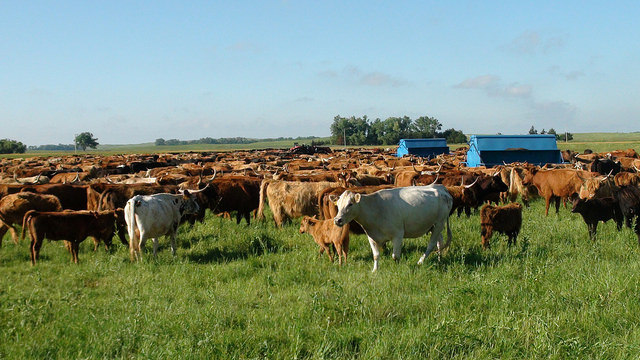April 8, 2015

Last week, I kicked off my weekly grazing series for the month of April. Each Thursday, we’ll explore production tips for ranchers to get more out of their pastures and hay fields. This week, we’re looking at extensive vs. moderate grazing methods, including rotational grazing and mob grazing, as well as the effectiveness of cross-fencing, and a whole lot more.
In case you missed it, here’s the first segment of the series: Grazing Series Part 1: 3 tips for spring hay & pasture management
Here are three grazing management systems to consider:
1. Use cross fences to increase pasture carrying capacity.
Bruce Anderson, University of Nebraska-Lincoln Extension forage specialist, says electric fences are the easiest and cheapest way to increase production from summer pastures.
READ: How to use temporary fencing for controlled grazing
Anderson writes, “Dividing pastures with electric cross fences gives you more control of when and where your cattle graze. It helps you encourage cattle to graze pastures more uniformly and completely, including areas they normally avoid. And, it can help you improve the health and vigor of your grass by giving it time to recover and regrow after each grazing. As a result, your grass production and pasture carrying capacity will increase. This will be especially valuable this year considering the currently high cost of pasture. So, as spring growth of your pastures begins to slow down, use your winter electric fence to try some extra summer cross fencing of your pastures. More grass, better gains, and better profits might be the result.”
Subscribe now to Cow-Calf Weekly to get the latest industry research and information in your inbox every Friday!
2. Ultra-high stock density grazing can increase forage utilization.
Anderson says the popular method of mob grazing is often implemented incorrectly as ranchers are more likely just strip grazing or rotating very rapidly.
See mob grazing in action here!
He says, “What is meant by ‘ultra-high’ mob grazing is debatable but many folks consider about 3,000 pounds of animals per acre as the minimum to qualify for this category. That means you need the equivalent of around 200+ cow-calf pairs per acre. Two hundred pairs will eat 4-5 tons of forage each day so they can stay on that small piece of ground for only a brief time. In fact, this mob of animals often is moved to fresh pasture several times each day.”

Photo Credit: University of Nebraska-Lincoln 2013 mob grazing tour
READ: Is it time to alter your grazing management?
Anderson explains that mob grazing improves nutrient cycling and improves forage utilization because animals don’t have time to graze selectively in a short period of time. Plus, if done correctly, mob grazing reduces trampling, spreads manure uniformly, and helps control weeds.
3. Extensive vs. intensive grazing
Dave Lalman, Oklahoma State University Extension beef cattle specialist, studied extensive vs. intensive grazing to evaluate the best approach for producers in times of drought and high cost of land. In his study, Lalman considered extensive grazing which implements moderate grazing over a larger number of acres and an intensive system that utilizes cropland to reduce the amount of pasture needed.
READ: Combine stockpiling and faster rotation
Lalman found that the extensive grazing used more land but fewer inputs. His study used a moderate-to-low stocking rate of 13 acres per cow-calf unit. If stocking heavier than that, more hay will be needed. Meanwhile, Lalman’s intensive system used cover crops on cropland which ultimately produced more pounds of beef but also cost more money per animal.
Click here to listen to Lalman’s interview with Ron Hays to learn more about the OSU study on extensive vs. intensive grazing.
Which grazing method do you prefer to utilize in your pastures? Share your tips and success stories in the comments section below.
Don’t forget to tune in next Thursday for the third segment in our grazing series where we will focus on cover crops and more.
The opinions of Amanda Radke are not necessarily those of Beefmagazine.com or the Penton Farm Progress Group.
You might also like:
Prevention and treatment of cow prolapse
9 new hay-making tools for the 2015 forage season
Bale grazing lets cows feed themselves
You May Also Like


.png?width=300&auto=webp&quality=80&disable=upscale)
